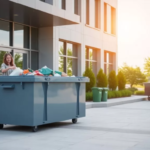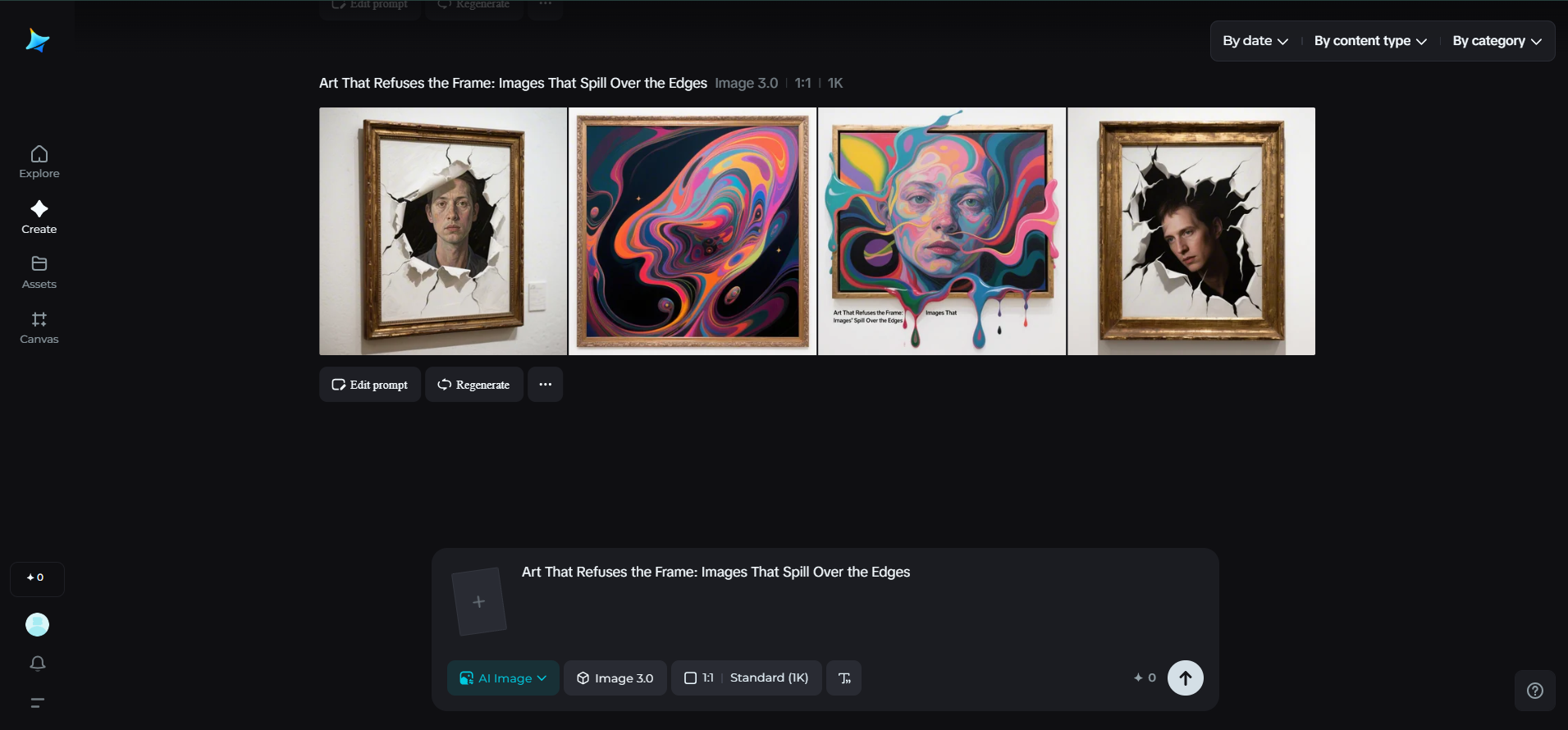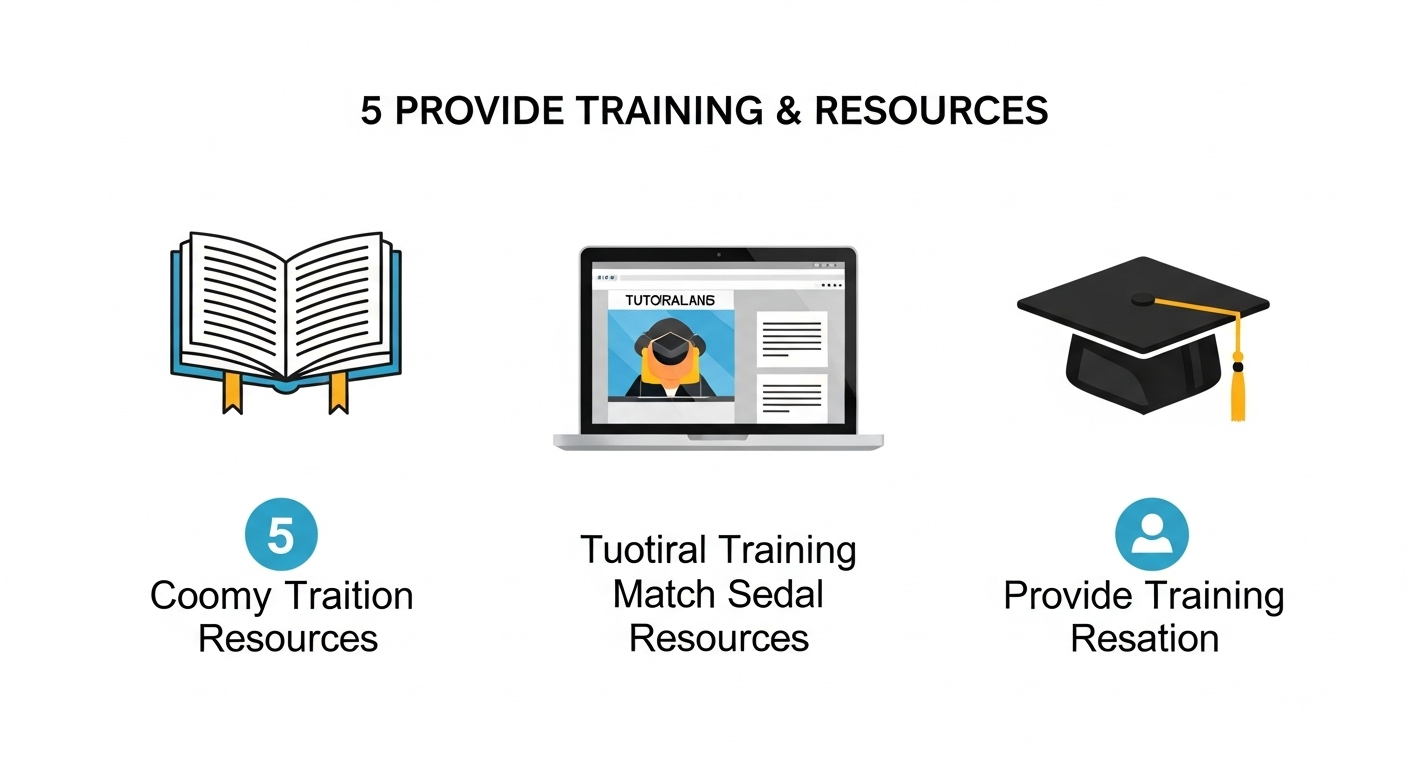There’s a thrill in seeing a painting that keeps going—where a brushstroke escapes the stretcher, where a mural slurps the sidewalk, or where a GIF refuses to be polite and crawls across your browser tabs. If you’ve ever wanted to make that feeling tangible—capture the messy exhilaration of work that won’t be boxed in—try start with a mood image.
Drop a few dozen sensory words into Dreamina’s AI photo generator and you’ll get plates that show what “overflow” looks like: torn paper, paint running across tile, or a collage that breathes past its margins. Those plates aren’t the final thing; they’re permission slips. This essay is for people who like edges that argue back—creatives, curators, and designers who want their work to be porous, social, and a little inconvenient.
We’ll wander through forms that spill—gallery interventions, interactive webpages, and tactile pieces that invite touch—then outline a playful three-step Dreamina workflow for turning the spill into shareable images. Expect short paragraphs, a few compact bullets, and practical creative prompts you can try in an afternoon.
When the work keeps walking: types of spillover
Art refuses the frame in many delicious ways. Here are a handful of archetypes to recognize (and to borrow from):
- Mural migration: paint that leaves the wall to run onto pavement, furniture, or an adjacent façade—urban work that forces pedestrians into a new choreography.
- Material overflow: collage, resin, or textiles that deliberately outgrow conventional supports—think stitched canvases whose threads trail onto the floor.
- Interactive drift: digital works that ignore viewport boundaries—elements that anchor to scroll position and continue their narrative across site navigation.
- Auditory spill: sound installations that leak into adjacent rooms, changing the listening experience for accidental passersby.
Each of these modes shares one intention: to involve the environment, not just decorate it.
Designing an edge that invites, not annoys
An active edge should feel generous. If a piece crosses into someone else’s space, ask: Is it readable? Is it safe? Is it delightful? A few quick rules keep spillovers charming rather than invasive.
- Keep legibility in mind: if text crosses a threshold, make sure its meaning survives the move.
- Design for bodies: think about how people will physically meet the overflow; leave circulation space.
- Imagine duration: weather, wear, and human touch change spills—choose materials and placements that age gracefully.
These are practical choices, but they preserve the spirit: work that insists on being part of daily life.
A simple Dreamina exercise to visualize your spill
If you’d like to prototype a spill concept—say, a painting that seems to ooze into an adjacent doorway—Dreamina helps you make mockups that feel tactile and urgent. Here’s a fast loop to go from idea to visual proof.
Step 1: Create a detailed text prompt
Go to Dreamina and fill out a detailed prompt outlining the spill idea, emphasizing texture, movement, and setting.
For instance: Late afternoon light, a little shadow, a glossy sheen from the resin, and faint scuff marks where feet pass are all features of this cobalt paint mural that appears to spill off the wall of galleries and pool across the entrance onto a wooden floor.
To help the model understand physicality, keep it imagistic and add materials and lighting.
Step 2: Set parameters and generate
Choose a model adjusted for textures and materials, select an aspect ratio that approximates the installation (wide for floor-to-wall spreads), select size, and select 1k for quick drafts or 2k for print-ready images. Click Dreamina’s icon to create a number of variations; compare silhouettes and how well the spill is readable as three-dimensional.
Step 3: Tailor and download
Apply Dreamina’s inpaint to fine-tune the spill edge, expand to demonstrate how it intersects with surrounding architecture, remove distracting background objects, and retouch the gloss and grain until the material looks true. When the picture demonstrates the spill acting as expected, click the Download icon and utilize the mockup to communicate the project to coworkers or investors.
Choreography and accidental audiences
Spillover art performs for audiences who didn’t buy tickets. Consider three simple interactions: the glance, the linger, and the touch. A successful spill invites a glance (quick recognition), supports a linger (something deeper if you stay), and resists unwelcome touch (materials that invite curiosity but aren’t dangerously sharp). Map likely pedestrian lines, seating clusters, and sightlines before committing to a drift.
Small provocations you can try tomorrow
You don’t need a city permit to experiment. Try these micro-projects:
- A postcard series printed with a painted edge that continues beneath the stamp—mail them and watch the return photos.
- A short looping web animation that bleeds out of its iframe into the page’s margins, then retreats on hover.
- A window sticker set designed to overlap across panes—when multiple units in a building participate, the image completes across apartments.
These tiny provocations teach you how spill functions at human scale.
Texture and seam: material choices that make the spill believable
Spill demands materials that read as continuations. Use adhesives that age well, threads that fray attractively, or projection mapping that aligns with cracks and relief. Test small sections before full-scale commitment—resin drips on an experiment board, printed overlaps taped to a storefront, or a low-res projection rehearsal across a wall. These tests reveal surprises that sketches miss.
Collaborative spill: inviting neighbors into the composition
Because spill interacts with other people’s spaces, collaboration is an ethical shortcut to success. Invite building managers, shop owners, or online moderators into the concept stage. Make a simple agreement: what’s okay, when it’s okay, and how the piece will be maintained. Collaboration turns potential conflict into co-authorship—your spill becomes shared infrastructure rather than vandalism.
Making the art spill feel physical
Artwork can emulate a physical spill by extending past the canvas, allowing paint, fabric, or sculptural elements to overflow onto the wall, floor, or frame. Use subtle shifts in material to imply weight—shadows that fall beyond the stretcher bars, drips that tug pigment downward, or textures that seem to pull the viewer’s gaze off the edge. Sound can even be introduced through rustling materials, layered surfaces, or placements that respond to how the viewer moves around the work. Dreamina’s free AI art generator allows you to achieve this artwork in seconds.
Display systems that honor the live edge
When showing spill pieces in galleries, create clear narrative anchors: a single framed object surrounded by intentional emptiness, a set of floor markers indicating where the work will touch people, or a simple label that reads: “Edges may move.” These curatorial moves let visitors consent to being swept up.
The small ethics checklist
Spill is generative when it’s temporary, non-damaging, and reversible. Avoid adhesives that harm surfaces, don’t obscure access, and never target private property. Design for removal and repair. Leave a restoration plan and a contact card in plain view—good spill is accountable spill.
Signature moves: small forms that make a big splash
Some spill tactics return again and again because they feel generous: a painted stripe that completes a crosswalk pattern, a projection that animates a storefront at closing time, or a stitched canvas whose tail is handed to a neighbor as a scarf. These moves are repeatable and easy to scale.
Logos that learn to breathe
If your project needs a tiny identity—a mark that can sit on postcards, patches, or web headers—keep it simple and adaptable. Consider using Dreamina’s AI logo generator to explore lockups that behave well when cropped, animated, or embossed on materials with active edges. A lockup that works as both sticker and watermark is a handy asset for spill projects that travel.
Closing the frame and opening the city
Art that refuses the frame asks for humility and generosity. It asks you to design with others rather than at them. Creative spill invites strangers into a shared choreography and changes how we move through space.
Dreamina gives you a quick visual rehearsal—mood plates and mockups that help you argue for a project, prototype an idea, or persuade a partner to let the work step off the wall. Make small tests, get permission, and design for removal; when your art starts to wander, let it be kind and curious.
Then download the mockups, pin them to your proposal, and go place a little beautiful trouble in the world.











